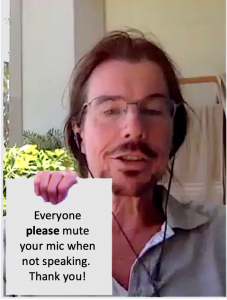
Translation: We can hear you eating, slurping, whispering, muttering, talking with others in the room, and/or making other unpleasant and disruptive bodily sounds, even over the sound of the person speaking. |
We’re all getting used to using Zoom and similar services in place of face-to-face get-togethers of every kind. It hasn’t taken long for a new etiquette to begin to emerge among regular, and even irregular, users of these tools.
A while ago, some organizations introduced small card decks with useful messages that could be held up to inform the current speaker of technical problems, or how they could improve their presentation. They include “unmute your mic”, “louder”, “not so loud”, “faster”, “not so fast”, “you’re breaking up”, “be right back”, “I have a question”, “I have a concern”, “thumbs up”, “thumbs down”, “thank you (or applause)” and of course “ELMO” (“enough, let’s move on”). I’ve used them to quietly communicate to the speakers on several Zoom calls, and they really work. Just print each of ’em on an 8.5″ x 11″ sheet of paper in large font, and even in large groups they’ll be visible when you hold them up. The one I’ve used most? “Not so loud, please.” — especially for older users who tend to think they have to shout to be heard on a microphone — a bad habit picked up from cell phones I think.
I thought it would be fun to come up with messages for the more unruly, less skilled (trying to be polite here) audiences that you’ll find in some Zoom conferences. The message at the top of this post is an example. Here are a few more:
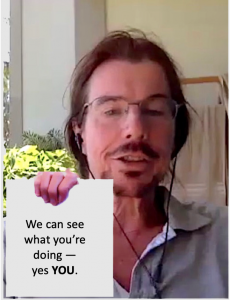
Translation: This is for those who think they can play video games, answer e-mail, talk on the phone, clean their laptop/house/car (yes I’ve seen this), brush their teeth, pick/scratch their…., make disparaging or disconcerting faces, change their clothes etc and because someone else is speaking and they’re muted, that no will will notice they’re NOT PAYING ATTENTION. We notice. So does the speaker. Upload a still photo of yourself and “mute” your camera if you must do something visually distracting during the meeting, please. |
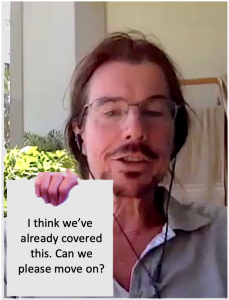
Translation: It’s polite to sign in 5-10 minutes before the meeting starts, so you don’t miss anything. This is for the people who are either chronically late, and make people repeat what was already said to the punctual, and the people who only pay attention to their own voice, so they ask questions or post comments or concerns that have already been discussed. If you’re late, precede comments with “Sorry I was late; if this hasn’t already been covered…” |
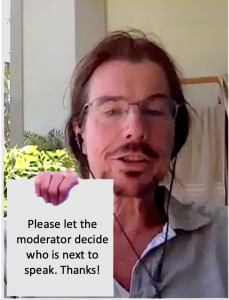
Translation: Share the airtime fairly, don’t interrupt, tell the moderator, using a chat message, that you’d like to say something rather than cutting in whenever there’s a silence. This message sometimes even works on narcissists (and some old white males) who will otherwise often try to hog airtime (more so with really big audiences). Good moderators will keep a “queue” of who’s next to speak or ask a question. And another hint: Say “that’s all” or “thanks I’m done” to signal the moderator to cue up the next speaker. |
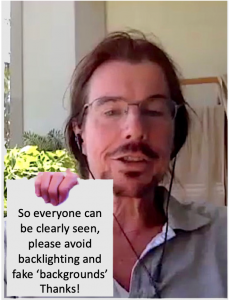 Translation: This message is better communicated by the moderator in the chat at the start of the meeting rather than in a held-up message, but it’s really important. Photographers know that portraits are best with the bright light in front of the subject, never behind, and that some light is needed in front of you. It’s really disconcerting when people can’t see you (as if you’re wearing a mask). And fake ‘backgrounds’ with friends & family are fun, but distracting in most settings (especially if the Getty Images watermark is visible on your background — true story). Translation: This message is better communicated by the moderator in the chat at the start of the meeting rather than in a held-up message, but it’s really important. Photographers know that portraits are best with the bright light in front of the subject, never behind, and that some light is needed in front of you. It’s really disconcerting when people can’t see you (as if you’re wearing a mask). And fake ‘backgrounds’ with friends & family are fun, but distracting in most settings (especially if the Getty Images watermark is visible on your background — true story). |
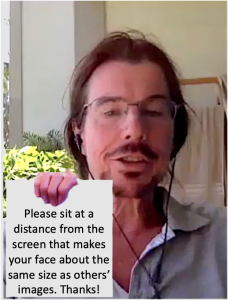
Translation: This is another subtle but important ‘unintentional body language’ learning for online newbies. Sit too far away and people will think you’re disengaged. But sit too close and they’ll think you’re ‘crowding’ them. Trying to get everyone the same distance from the screen can make people feel more at ease and more like ‘equals’. |
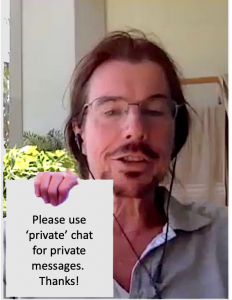
Translation: This is another tricky one, analogous to the improper use of ‘reply all’ in email. Zoom lets you send 1-to-1 messages to any participant in the ‘chat’ window, but you have to take care to reset the recipient before each chat message you send. Not terribly intuitive but valuable learning to keep the ‘chat with all’ messages free of clutter, and to avoid embarrassing messages inadvertently sent to all. |

Translation: This is probably the most important message to keep in mind. It can be tempting to laugh when someone says something unintentionally foolish or rambles on incoherently, and with your screen on Gallery setting, that laughter can be infectious. Nothing ‘s scarier than seeing a bunch of people laughing or shaking their heads at you, even when the sounds are all muted. We’re all doing our best. |
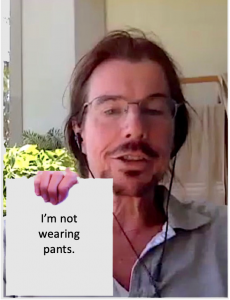
Translation: Here’s your chance to show off your unique sense of humour. These are crazy days, and laughter is great medicine. Come up with 1-2 silly, funny, short, inoffensive signs for each Zoom session, and then hold each of them up just for a couple of minutes during the session (not at critical moments though) to help the group cut through the tension of the times. |
A note about children: If it’s a family & friends meeting, of course children are welcome to come and go and participate. But if there’s serious stuff being discussed, as difficult as it is, it’s really important to keep them occupied and off-camera (and mic) unless they’re really quiet and unobtrusive. A message I saw on a recent Zoom call was “Yes your children are adorable but geez.” That about sums it up.
A note about pets: As unfair as it may be, the above caveat does not apply to pets. I’ve observed on several occasions that the quiet appearance of pets walking in front of the camera seems to be a universally delightful distraction — a reminder that in the current time of crisis there are creatures equanimous and oblivious to what is happening, and wouldn’t it be nice if we could take it all in stride as well as they seem to.
You’ll notice in the images above I appear to have my eyes downcast. You’ve probably noticed the same is true of most Zoom participants. This is because the built-in camera is above the centre of the screen which most people focus on. There’s no easy fix for this, but it’s something for computer and webcam designers to focus on. You can prop your computer up on a box so you’re looking up at both the screen and camera, but that can be awkward, especially with laptops. And you can position an external USB camera at mid-screen height to the left or right of your monitor, but then you’ll usually seem to be looking to the side of the camera (better, but not great).
And in every group, it seems, there is someone who cannot resist trying the “screen sharing” button. Best for moderators to turn this facility off for everyone to avoid the temptation, and only turn it on in rare circumstances when screen-sharing is actually of value.
You may not agree with all of the above, but I hope you find this all useful.
Finally, for those of you who understand the story of Passover, you might appreciate this bit of Zoom humour by poster eitzpri on Reddit:
The Torah Speaks of Four Kinds of People Who Use Zoom:
The Wise
The Wicked
The Simple
The One Who Does Not Know How to “Mute”The Wise Person says: “I’ll handle the Admin Feature Controls and Chat Rooms, and forward the Cloud Recording Transcript after the call.”
The Wicked Person says: “Since I have unlimited duration, I scheduled the meeting for six hours—as it says in the Haggadah, whoever prolongs the telling of the story, harei zeh ‘shubach, is praiseworthy.”
The Simple Person says: “Hello? Am I on? I can hear you but I can’t see you.”
[Jerusalem Talmud reads here: “I can see you, but I can’t hear you.”]The One Who Does Not Know How to Mute says: “How should I know where you put the keys? I’m stuck on this stupid Zoom call with these idiots.”
To the Wise Person you should offer all of the Zoom Pro Optional Add-On Plans.
To the Wicked Person you should say: “Had you been in charge, we would still be in Egypt.”
To the Simple Person you should say: “Try the call-in number instead.”
To the One Who Does Not Know How to Mute you should say: “Why should this night be different from all other nights?”
Take care, everyone.





Wonderful, Dave. Thanks for this. The third one’s particularly relevant if not everyone has a fast Internet connection — it’s very easy for them to be shut out of the conversation (I speak from experience here).